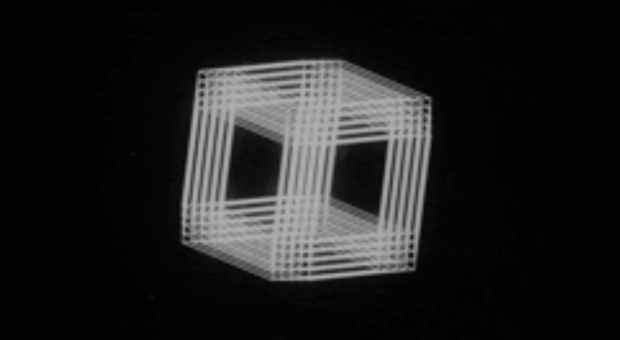Manfred Mohr “A Formal Language Celebrating 50 Years of Artwork and Algorithms”
Bitforms Gallery

[Image: Manfred Mohr "Cubic Limit" (1973 –1974)
This event has ended.
bitforms gallery is pleased to celebrate the 50th anniversary (1969 – 2019) of Manfred Mohr writing and creating artwork with algorithms. This exhibition showcases poignant moments throughout the artist’s career, presenting pre-computer artworks from the early 1960s alongside programmed film, wall reliefs, real-time screen-based works, computer-generated works on paper and canvas, and ephemeral objects. Mohr utilizes algorithms to engage rational aesthetics, inviting logic to produce visual outcomes. A Formal Language (named after his 1970 computer drawing) follows the evolution of the artist’s programmed systems, including the first computer-generated drawings to the implementation of the hypercube. While Mohr’s career spans over sixty years, this exhibition distinguishes his pioneering use of algorithms decades before it became a tool of contemporary art.
In the early 1960s, action painting, atonal music, and geometry were of great interest to Mohr. His early works indicate a confluence of interests in jazz and Abstract Expressionism through weighted strokes and graphic composition. Mohr was connected to instrumentation as a musician himself, playing tenor saxophone and oboe in jazz clubs across Europe. As his practice continued to progress, Max Bense’s theories about rational aesthetics greatly impacted Mohr, ushering in binary, black and white palettes of logical, geometric connections that would soon become his signature.
Mohr wrote his first algorithm using the programming language Fortran IV in 1969. He plotted the resulting computer-generated data by hand, an exhausting and unsustainable process of intricate drafting. Systems capable of drawing the results of algorithms were not easily accessible at this time. However, in the autumn of 1969 Estarose Wolfson, the artist’s future wife and a mathematician, connected Mohr to a lab in New York. P-018 (1969) is a series of artworks drawn with light beams directly onto photo paper, allowing the artist to view multiple results generated from the same algorithm for the first time. In early 1970, the artist was granted one-time permission to use a flatbed Zuse pen plotter at the University of Darmstadt in Germany. From 1970–1983, Mohr gained unique access to the computer center at the Météorologie Nationale in Paris where he used a high-resolution vector flatbed pen Benson plotter and CDC 6400 computer. The resulting diversity of artwork confirmed the urgency and aesthetic significance of his algorithms. Thus, Mohr continued to exclusively produce artworks using self-authored computer programs.
In 1971 ARC, Musée d’Art Moderne de la Ville de Paris, presented the first solo exhibition of computer-generated digital art in a museum, Manfred Mohr: Une Esthétique Programmée. Within the exhibition, Mohr showed over 20 plotter drawings, demonstrated his practice on a flatbed plotter, and designed a wall panel that prompted visitors with the question, “What do you think of aesthetic research that is assisted by a computer?” The responses serve as an exceptional survey of opinions at that time. Fifty years later, the connections Mohr establishes between aesthetics and instruction continue to stimulate dialogue within the contemporary art world.
Mohr experienced unparalleled success creating algorithmic artwork. Through the application of his musical knowledge, he defined the fixed structure of the hypercube as his Visual Instrument. Mohr explains, “The cube and hypercube are structures having fixed relationships between vertices, edges, and planes. In all algorithmic systems, I find and create new and different relationships that are inherent in the structure. This becomes my Visual Instrument.” Mohr uses the cube as a generator of artworks, demonstrated by the film Cubic Limit (1973 – 1974). Exhibited at the gallery in the original 16mm format, this work is an early example of the cube appearing in Mohr’s oeuvre.
The intricacy of Mohr’s work with algorithms, the cube (since 1973), and the hypercube (since 1977) has only increased over the decades. The series space.color (1999) inaugurated the artist’s use of color as a result of new parameters of spatial differentiation and complexity of an inconceivable structure. In 2002, Mohr started to build his own computers for which he implemented space.color, resulting in his first non-repeating, real-time, screen-based animation, space.color.motion (2002). Within this series, paths through the network of the hypercube structure are rotated and projected into two-dimensional space, forming entirely unique configurations.
The last 50 years of Mohr’s work is divided into work phases of two to three–year cycles. His most recent work phase, Algorithmic Modulations (2019), augments this graphic construct within the diagonal paths of a 12-dimensional hypercube. The trajectory of this shape is marked in transparent color bands. Thick, horizontal lines reflect the vertex points, adding a contrastive weight to the diaphanous structures. Mohr’s artworks move beyond imagination, functioning as a representation between points, lines, squares, and cubes after they have been divided and reconstructed in different dimensions.
Media
Schedule
from September 07, 2019 to November 03, 2019
Opening Reception on 2019-09-07 from 18:00 to 20:00